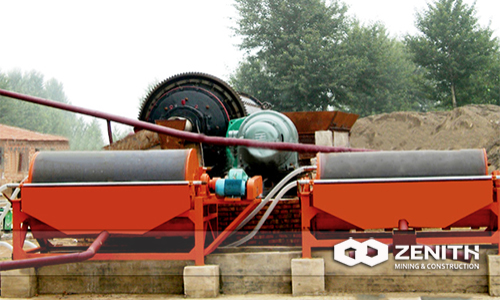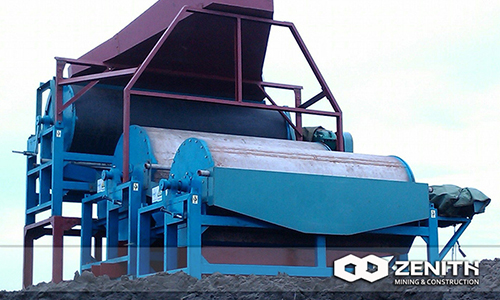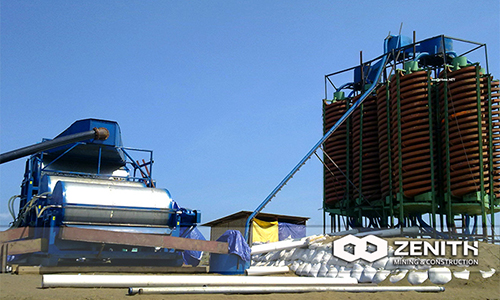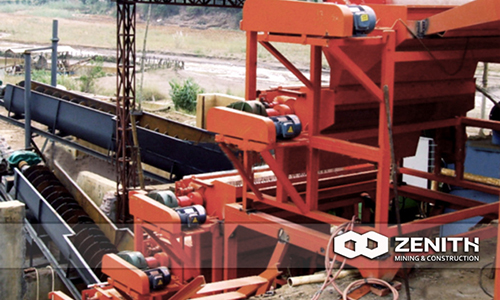The Mn element is very important in the metallurgy and other fields. 90% of iit is used in the steel industry for improving the hardness, strength, abrasive resistance, toughness and hardenability of the steel. The rest Mn element is used for making welding rod, glass, ceramic, medicine, agriculture and environment protection, etc. Here is the brief introduction of the manganese ore and the solution for the manganese ore processing.

1. The brief introduction of manganese ore
Mn is lithophile and it is always occurrence in the oxidate, hydroxide and carbonate. All the manganese ore can be classified into the manganese carbonate ore and manganese oxide ore. The manganese carbonate contain the magnesite, Calcium magnesite, tetalite and so on; The manganese oxide ore is include the pyrolusite, psilomelane and braunite. Mn is always associate with the Fe, Cu, S and Pb elements. Especially when the manganese ore is associate with the hematite, siderite and limonite, it is very hard to separate them. Because all of them are theweak magneticism mineral. Here is the common manganese ore's physical property as below:
| Name | Content | Specific gravity | Color | Theoretical grade | |||
| Rhodochrosite | MnCO3 | 3.3-3.7 | Pink or White | 47.82% | ≥10% | ≥15% | 3.5-4.6 |
| Tetalite | (Ca, Mn) CO3 | 2.7-3.8 | Pink or White | 46.65% | ≥10% | ≥15% | 3.5-4.5 |
| Psilomelane | mMnO·MnO2·nH2O | 3.7-4.7 | Dark or Grey | -- | ≥10% | ≥15% | 4-6 |
| Pyrolusite | MnO2 | 4.3-5 | Ocher or brown | 63.19% | ≥10% | ≥15% | 2-5 |
| Braunite | Mn2O3 | 4.7-5 | gray black | 69.90% | ≥10% | ≥15% | 6-6.5 |
2. The processing technology for the manganese ore:
Manganese carbonate ore:
a. High intensity magnetic separation technology; ( Always use the Low intensity magnetic separation to remove the strongly magnetic mineral )
b dense media separation
c. Flotation technology
Manganese oxide:
a. Gravity separation
b. Washing+ Gravity Separation
c. Washing+ Gravity Separation+ High intensity magnetic separation
3. How to setup the manganese ore processing plant?
Frist, doing the geological prospecting to know the
deposit, position and the trend of your mine and make
sure it is with the the feasibility of developing or not.
Second, doing the dressing test is for choosing the suitable and economical mineral processing technology and recovering the Cu element inside the raw ore after detailed experimental study. The research report will be as the basis of the project feasibility study.
a. Spectral analysis & elements chemical analysis to fix the chemical composition of Manganese ore. And the grade of the Mn elements is around 19.99%.
| Elements | Mn | Fe | P | SiO2 | Al2O3 | CaO | MgO |
| Cotent % | 19.99 | 8.02 | 0.032 | 12.18 | 20.6 | 7.78 | 2.84 |
| Elements | Cu | Pb | TiO2 | S | As | Na | K |
| Cotent % | 0.067 | 0.016 | 0.63 | 5.77 | 0.026 | 0.08 | 0.65 |
| Elements | Co | Ni | C | V | Au | Ag | Loss On Ignition |
| Cotent % | 0.009 | 0.014 | 9.23 | 0.03 | 0.05 | 1.92 | 20.32 |
b. Manganese ore phase analysis to fix the type of your Manganese ore and the gangue name.
| Item | Pyrite | Alabandite | Phosphorus pyrite | Clay | Quartz | iron-manganese oxides | Rhodochrosite |
| Content % | 12.2 | 1 | 0.2 | 14.6 | 1.4 | 0.2 | 28.3 |
| Item | mangano-calcite | Tetalite | With manganese calcite | capillitite | Calcite or Dolomite | Other | |
| Content % | 16.5 | 12.3 | 2.5 | 8.7 | 2.1 | -- | |
c. The texture and structure and mineral composition of the ore; To know the valuable mineral of your Manganese ore like the tetalite, manganocalcite, rhodochrosite, capillitite and the gangue which is associated with the manganese ore like,clay, pyrite, quartz, calcite etc.
| Item | Essential mineral | Auxiliary minerals | Tiny traces of minerals | ||||
| Valuable mineral | Rhodochrosite, Tetalite | Mangano-calcite, capillitite | with manganese calcite | ||||
| Gangue mineral | clay, pyrite | calcite, quartz | Calcite or Dolomite |
d. The major metal mineral's embedded features; The Major element mineral's dissociation. To fix the suitable particle size to separate the valuable mineral and gangue.
| Particle Size | manganese carbonate mineral | Pyrite | |||||
| Monomer | Coalition | Monomer | Coalition | ||||
| -0.5+0.18 | 68 | 32 | 63 | 37 | |||
| -0.18+0.076 | 77 | 23 | 78 | 22 | |||
| -0.076+0.037 | 85 | 15 | 86 | 14 | |||
| -0.037 | 88 | 12 | 85 | 15 | |||
e.Heavy liquid separation test: To fix the suitable heavy modia, the suitable particle size and specific gravity of separatrion and the selection Index.
| Density (g/cm3) | Yeild Rate % | Grade % | Mn/Fe | Metal distribution | |||
| Mn | Fe | Mn | Fe | ||||
| +3.3 | 50.9 | 24.64 | 15.78 | 1.56 | 61.7 | 82.9 | |
| -3.3+3.1 | 18.7 | 26.4 | 4.33 | 6.1 | 24.3 | 8.3 | |
| -3.1+2.89 | 13.2 | 17.45 | 3.82 | 4.57 | 11.3 | 5.2 | |
| -2.89+2.7 | 2.9 | 11.25 | 3.71 | 3.03 | 1.6 | 1.1 | |
| -2.7+2.6 | 1.4 | 6.42 | 4.15 | 1.55 | 0.4 | 0.6 | |
| -2.6 | 12.9 | 1.02 | 1.41 | 0.72 | 0.7 | 1.9 | |
| Total | 100 | 20.33 | 9.69 | 2.1 | 100 | 100 | |
When the density is 2.89 g/cm3, the recoery rade of the Mn is 97.3% and the Fe is 96.4%. Mn/Fe is 2.1. By this density the yeild rate of tailing is just 17.2%.
f. Magnetic analysis: To fix the suitable magnetic density to cocentrate the manganese ore.
| magnetic density (A/m) | Yeild Rate % | Grade % | Mn/Fe | Metal distribution | |||
| Mn | Fe | Mn | Fe | ||||
| <440 | 0.6 | 15.42 | 23.45 | 0.66 | 0.4 | 1.5 | |
| 440 | 35.1 | 31.78 | 5.97 | 5.32 | 53.4 | 22.8 | |
| 503 | 29.1 | 23.33 | 6 | 3.89 | 32.5 | 19 | |
| 754 | 15 | 16.35 | 6.34 | 2.58 | 11.8 | 10.4 | |
| 1006 | 4 | 6.31 | 12.32 | 0.51 | 1.2 | 5.4 | |
| 1509 | 4 | 2.42 | 20.65 | 0.12 | 0.5 | 9 | |
| >1509 | 12.2 | 0.44 | 23.95 | 0.02 | 0.2 | 31.9 | |
| Total | 100 | 20.88 | 9.18 | 2.27 | 100 | 100 | |
When the magnetic desnsity is from 440 to 503 A/m, the yeild rate of magnetic mineral is 64.2%, the grade of Mn is 27.95%, Mn/Fe is 4.66. The total recovery rate of Mn is 85.9%. It is suitable to rich Mn and drop Iron.
g. Magnetic separation technology test:
| Item | Yeild Rate % | Grade % | Mn/Fe | Metal distribution | |||
| Mn | Fe | Mn | Fe | ||||
| Strong magnetic mineral | 0.72 | 11.2 | 31.99 | - | 0.42 | 2.72 | |
| Concentration Ore | 51.01 | 27.46 | 6.01 | 4.57 | 72.44 | 36.2 | |
| Middle Ore | 16.63 | 16.81 | 9.24 | 1.82 | 14.44 | 18.15 | |
| Total Mn | 67.64 | 24.86 | 6.8 | 3.65 | 86.88 | 54.35 | |
| Tailings | 31.64 | 7.77 | 11.49 | - | 12.7 | 42.93 | |
| Total | 100 | 19.36 | 8.47 | - | 100 | 100 | |
After doing the test, choose the one stage Low intensity magnetic separation to remove the strong magnetic minera. Then use two stages high intensity magnetic separation to improve the the grade of the manganese ore.

h.Exploratory Test; Make exploratory Test for the ore and make foreshadowing for condition test; If your manganese ore is rich in the Ti2O3, Cu, S, we can give you the advice to expand the production in the future.
i. Condition test; Base on the research, we will doing the condition test include grinding solution; grinding fineness; magnetic separation and flotation concentration solution; collector type and dosage; depressant type and dosage; activator type and dosage; modifier type and dosage; PH value; flotation time; pulp density, etc for fixing the technological parameter of beneficiation flowsheet;
j. Completely open closed-circuit test: Base on the above test, choose the beneficiation technology process and the process parameters. The test index should be with repeatability, stability and facticity.
k. Product check: Make multi-element analysis for the concentrate and tailing; Make sedimentation performance test for the concentrate and tailing.
l. Designing the beneficiation flow-sheet:Base on the above test, designing the most suitable beneficiation flow-sheet,technological parameter and reagent system.
m. Issuing Report Issuing report base on the above tests.
Third, choosing the suitable equipments base on the above test result.
Forth, build the foundation and doing the installation with our engineer. After receiving the deposit, we will send the technical drawing to you and send our engineer to supervise the foundation building and guide your staff to do the installation, then have a commissioning running. Meanwhile, they can train your staff at your site also.
4. Here is one project of Manganese ore ( Manganese Carbonate ) processing plant for your reference. Please see the flow chart of crushing section and beneficiation sections.
a. In the crushing section, we use our PE900x1200 jaw crusher to crush the manganese ore from 800 to 220 mm and then use the s series cone crusher S66" and S51"to crush the manganese ore from the jaw crusher into size 0-20mm. It is prepared for the beneficiation process.
b. The crushed manganese ore with size 0-20mm will be sent to the stone washer ZXL2200x8400 for remove the clay and soil. The ore with size 0-2mm will be sent to the spiral classifier 2ZFG2400 in the overflow. The ore with size 2-20mm will be sent to the vibrating screen 2YK1860 for classifying into 0-7mm and 7-20mm.
c. The 0-2mm from the stone washer and the 2-7mm from the vibrating screen will be sent to the spiral classifier 2ZFG2400. It will be classified into 0-1.3mm along with the overflow and the 1.3-7mm as the underflow.
d. The ore with size 7-20mm from the vibrating screen will be sent to the dry magnetic separator ZTLT350x1000 to do the concentration process. The concentration ore will be sent to the dry mixed ore stock pile. The tailing will be sent to the tailing pile.
e. The ore with size 1.3-7mm will be sent to the dry magnetic separator ZTLT300x1000 to do the concentration process. The concentration ore will be sent to the dry concentration ore stock pile. The tailing will be sent to the tailing pile.
"f. The ore with size 0-1.3 mm will be sent to the wet magnetic separator ZCT-B1060x1500 for rough concentration
to remove the strong magnetic mineral. The concentration ore will be sent to the high gradient magnetic separator ZTLGT2000 for selection concentration process. The concentrate ore will be sent to the thickner and vacuum filter for dewatering process. The concentration ore after dewaterting will be sent to the wet concentration ore stock pile. "
g. The talings from the high gradient magnetic separator will be dewatered in the settling pond and it will be sent to the tailings pile.
This design is just for your reference. The precise design for your plant should be done base on the dressing test of your raw mineral ore. Because this customer just want to improve the grade and selling the mineral ore directly.
5. Appendix:
Appendix I. The flow chart of the crushing section for manganese carbonate ore.
AppendixII. The flow chart of the beneficiation section for manganese carbonate ore.

6. Here is one project of Manganese ore ( Manganese Oxide ) processing plant for your reference. Please see the flow chart of crushing section and beneficiation sections.
a.The raw materials is fed to the jaw crusher PE500x750 by the vibrating feeder GZD850x3000. And the raw manganese ore will be crushed into 0-75 mm by the jaw crusher. The ore from the feeder and the jaw crusher will be sent to the stone washer ZXL2000x8000.
b. The ore with size 0-2mm will be sent to the shaking table 6S1850×4500 for gravity concentration process. The concentrationo re ( III grade) will be sent to the III concentration ore pile. The tailings from the shaking table wil lbe sent to the thickner NG-30 for dewatering process. Then it will be sent to the tailing lake by pump.
c. The washed ore with size 2-75mm will be sent to the vibrating screen 2YK2160. It will be classified into 0-7mm and 7-75mm. The ore with size 7-75 mm will be sent to the s series cone crusher S51" to crushed again. The ore after crushing by the cone crusher will be sent to the 2YK2160 and the ore with size above 7 mm will be sent to the cone crusher to crush it again until it is with size 0-7mm.
d. The ore with size 0-7mm will be sent to two sets jigger ZJT4-2 to do the roughing concentration. And then use one set ZJT4-2 jigger to do the selection concentration process.
e. The ore after processing by the above two satage will be sent to I set jigger ZJT4-2 to do the separation process and get II and III grade concentration manganese ore.
f. All the tailings from the two stage jigger will be sent to he high gradient magnetic separator ZTLGT1250 for scavenging concentration process. Then the final tailings wil lbe sent to the thickner NG-30 for dewatering process. Then it will be sent to the tailing lake by pump.
This design is just for your reference. The precise design for your plant should be done base on the dressing test of your raw mineral ore. Because this customer just want to improve the grade and selling the mineral ore directly.
7. Appendix:
Appendix III. The flow chart of the crushing and beneficiation section for manganese oxide ore.
